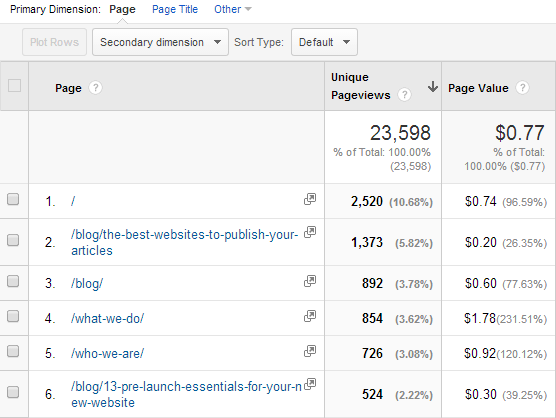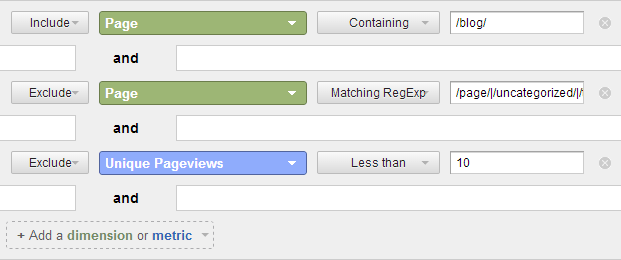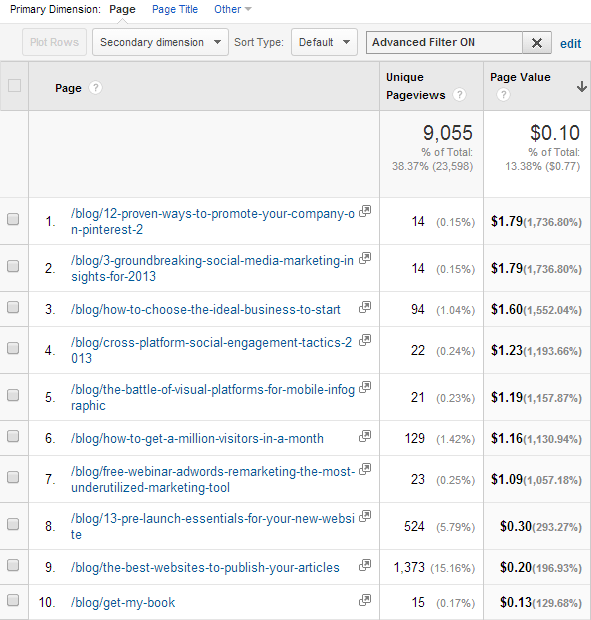I'm a data guy. Creative, too, but very much driven by data and ROI.
If you're ever struggling to come up with content for your site/blog (or if you simply wish to better understand the type of content putting money into your pocket), read on!
Despite being free, Google Analytics is an extremely powerful tool. It's easy to set up, too. Simply sign up for a Google account and install your tracking code, and you're ready to start collecting data.
It's through a bit of additional planning and setup, however, that it really starts to benefit your business.
Setting goals
Any time we take on a new client, one of the first things I look at is whether or not they have goals set up in Google Analytics. It baffles me just how many times there's absolutely nothing being tracked, especially when it's their second or third time working with an agency.
Another frequent issue is finding goals that have been set up without any sort of assigned monetary value. Even I made this mistake when starting out — it's extremely common.
If you're new to this process (or simply want a refresher), Google has some great fundamental resources to help you get the ball rolling:
Set up and edit Goals Goal types Goal ValueE-commerce sites make it easy to evaluate revenue and ROI because Google Analytics collects all sales data (with a bit of tweaking). If you aren't running an e-commerce site, it's vital that you assign appropriate monetary values to the completion of goals on your website. Doing so will open you up to a whole new world of tracking capabilities — it doesn't matter if you're a large corporation or one-(wo)man operation running a site about your cat.
Determining Goal Value
Not all goals are created equal.
A blog subscriber ≠ a newsletter signup ≠ a service inquiry.
For example, if the average one-time sale of your primary service is $10,000 and 15% of your leads make that purchase, each lead is worth $1,500. If you want to factor in profit margin and that margin is, say, 40%, each lead is actually worth $600.
Formulas $10,000 x 15% = $1,500/lead $10,000 x 40% x 15% = $600/lead
Establishing these figures also lets you know how much money you can spend on lead acquisition and still be profitable.
For micro conversions that lead people down your funnel, their value is typically much less. Someone subscribing to your newsletter might be worth $5, while someone subscribing to your blog may only be worth $2.
Once these figures are determined and goals are set, you can start looking at the individual value each page and article brings to your website.
Understanding Page Value
"Page Value" is a hit-level metric, meaning that it applies only to a specific page and not to the overall session of a user's visit. By comparison, "Goal Completions" and "Goal Value" are session-level metrics and not directly attributable to one page. In other words, it would be inaccurate to look at the number of goal completions provided for a specific page. Individual pages don't deliver goals and conversions; they simply move people through your funnel and toward a conversion.
One of the best articles you could ever read on this topic and its importance is Avinash Kaushik's article on session- and hit-level metrics. As such, what you want to focus on when looking at the impact of specific content on your site is the "Page Value" metric.
For an in-depth explanation of how Page Value is calculated, see this article by Google.
Evaluating Page Value
Start by going to Behavior > Site Content > All Pages. This is what you'll see:

Applying filters
Depending on where your content resides and what it is you wish to analyze, you may want to add a filter that includes traffic from only a specific directory. If, for example, you want to evaluate only your blog posts, and your blog resides in /blog/, click the "advanced" link next to the search box and use the following filter:

Once applied, only pages within the /blog/ directory will be displayed.
Looking through the results, however, you may see certain categories or types of URLs that you don't want to be included:
/page/2/ /page/3/ /category/uncategorized/ /tag/ etc.Without the optimization of your blog's settings/plugins, there may be a handful of others.
Instead of excluding each of these one filter at a time, you can use a simple line of regex to capture everything at once:
/page/|/uncategorized/|/tag/

The final thing to consider before evaluating Page Value is sample size. A page may appear to have significant value, but if the number of Unique Pageviews is too low, that value can be misleading. Send more traffic its way and see what happens before making any conclusions.
Also note that "too low" will, of course, depend on the amount of traffic your site receives as a whole.
At the very least, I recommend setting a filter to exclude pages with less than 10 Unique Pageviews. This helps weed out the anomalies:

With all filters applied, you now have a slightly tighter set of data with which to work.
Interpreting Page Value
Sort by Page Value and start looking at trends, patterns and top performers:

Perusing this data, you can see exactly what type of content, articles and categories are providing the most value.
Though the traffic in this example is limited, these same steps work for any site, regardless of current popularity.
Conclusion
With a bit of preparation and filter usage, you can know exactly what content is most valuable to your website and continue creating similar pieces. Whether for you or a client, taking a bit of extra time to gather and evaluate this information is a no-brainer.
Innovative SEO services
SEO is a patience game; no secret there. We`ll work with you to develop a Search strategy focused on producing increased traffic rankings in as early as 3-months.
A proven Allinclusive. SEO services for measuring, executing, and optimizing for Search Engine success. We say what we do and do what we say.
Our company as Semrush Agency Partner has designed a search engine optimization service that is both ethical and result-driven. We use the latest tools, strategies, and trends to help you move up in the search engines for the right keywords to get noticed by the right audience.
Today, you can schedule a Discovery call with us about your company needs.
Source:




![How To Create a Strategic Dashboard in Excel Using Semrush Data [Excel Template Included]](https://allinclusive.agency/uploads/images/how-to-create-a-strategic-dashboard-in-excel-using-semrush-data-excel-template-included.svg)
